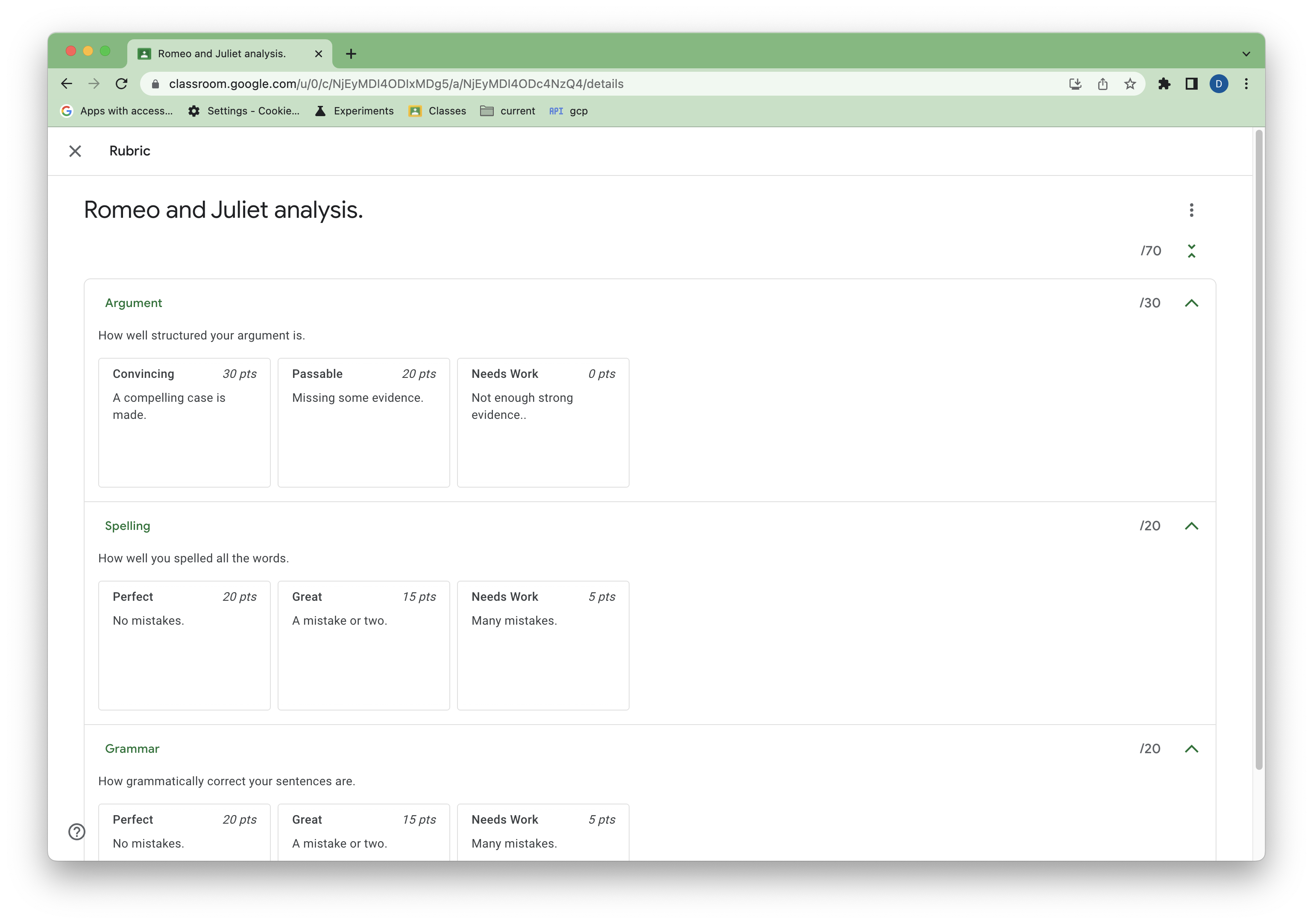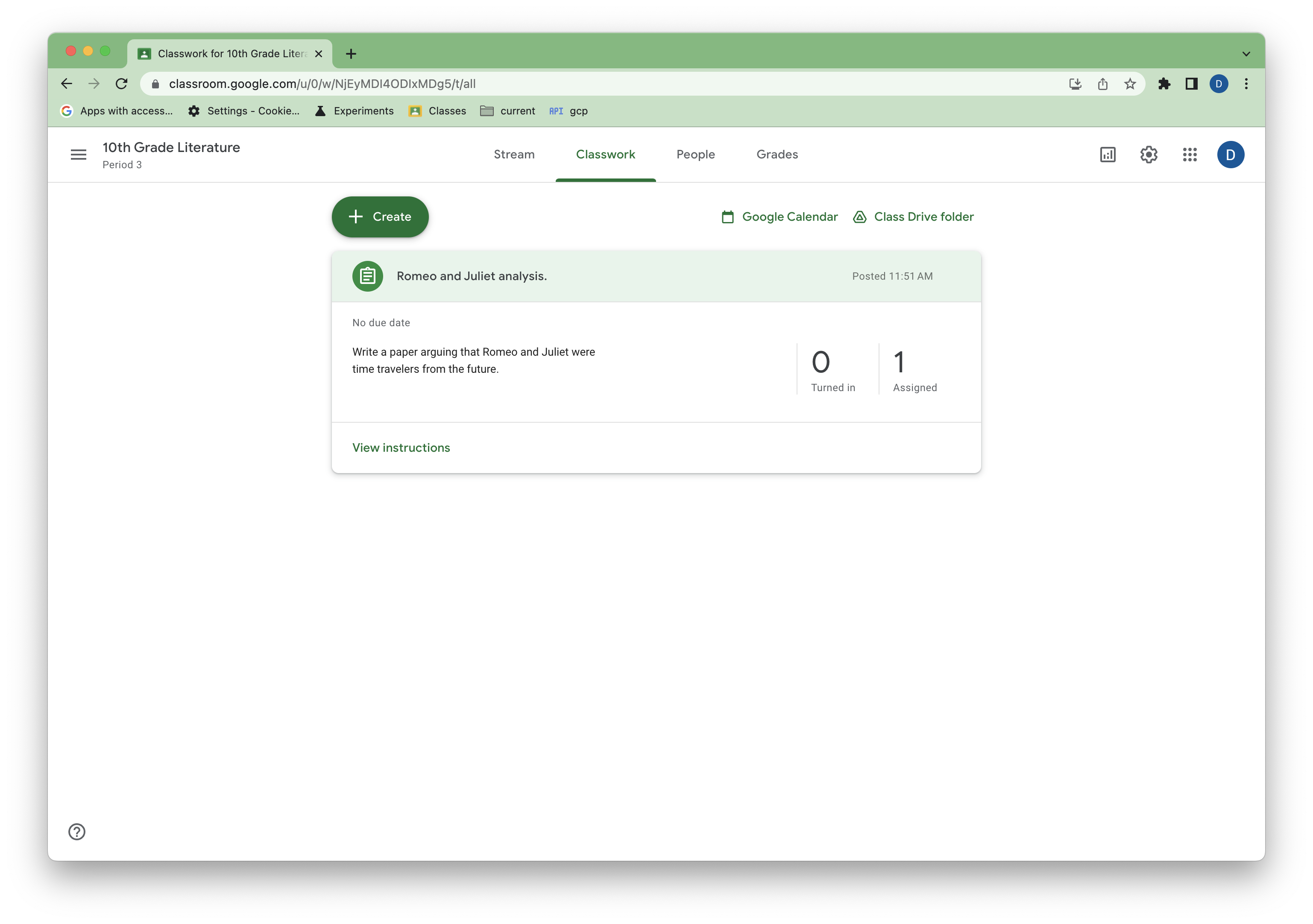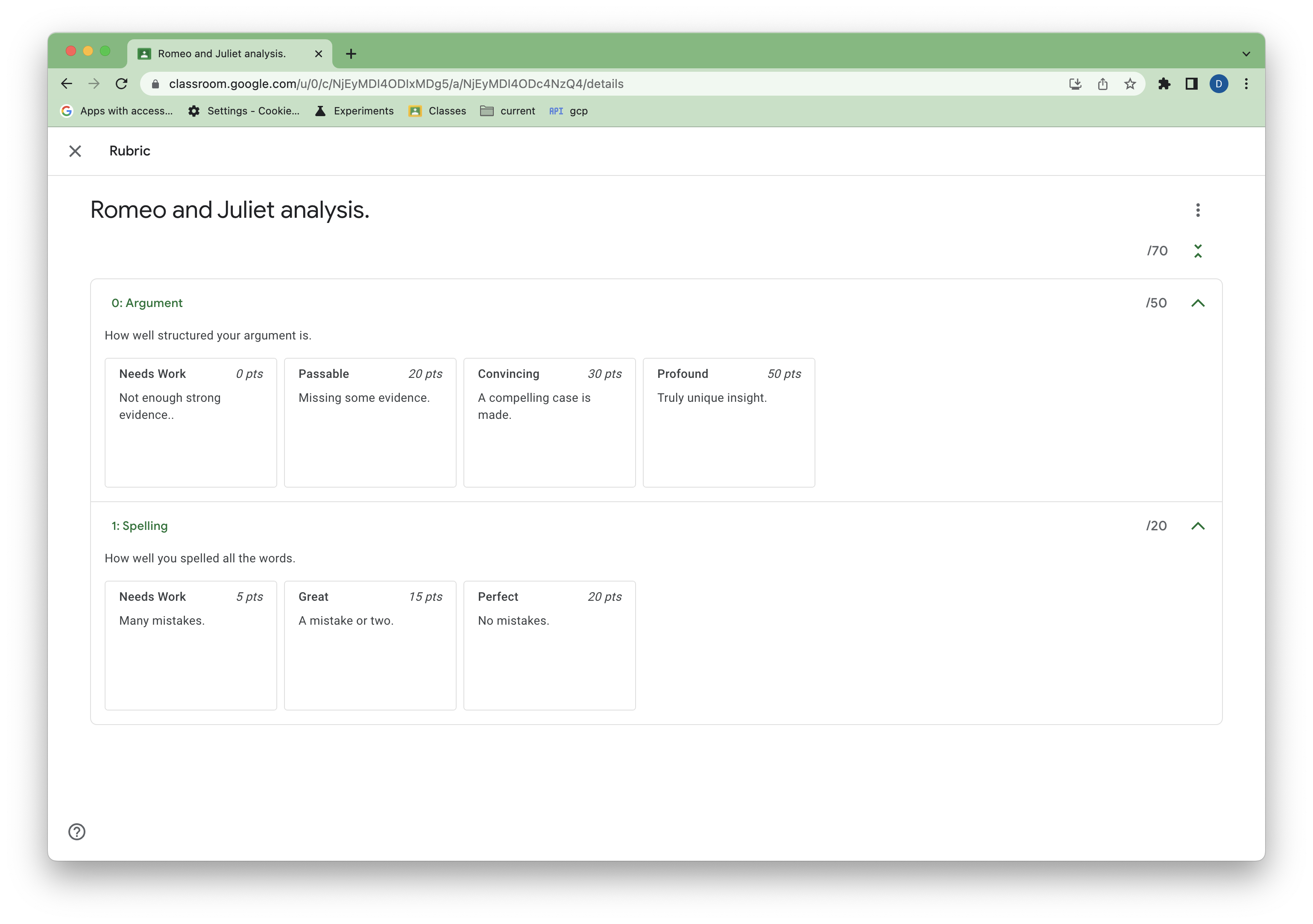rubric 是老師評分學生提交內容時可使用的範本。Classroom API 可讓您代替老師管理這些評量標準。
 圖 1. 查看 Classroom 作業的評分量表範例。
圖 1. 查看 Classroom 作業的評分量表範例。
本指南說明 Rubrics API 的基本概念和功能。請參閱這些說明中心文章,瞭解評分量表的「一般結構」,以及 Classroom UI 中評分量表的評分方式。
必要條件
本指南假設您具備下列條件:
- Python 3.8.6 以上版本
- pip 套件管理工具
- Google Cloud 專案。
- Google Workspace for Education 帳戶 (已啟用 Google Classroom)。
- 至少擁有一個測驗學生帳戶的測驗課程。如果您沒有可用來測試的 Classroom 課程,請在 UI 中建立課程,並新增測試學生。
授權電腦版應用程式憑證
如要以使用者身分驗證,並存取應用程式中的使用者資料,您需要建立一或多個 OAuth 2.0 用戶端 ID。用戶端 ID 可讓 Google 的 OAuth 伺服器識別單一應用程式。如果您的應用程式在多個平台上執行,則必須為每個平台建立專屬的用戶端 ID。
- 前往 Google Cloud 控制台的 Google Cloud 憑證頁面。
- 依序點選「建立憑證」 >「OAuth 用戶端 ID」。
- 依序點選「應用程式類型」>「桌面應用程式」。
- 在「名稱」欄位中輸入憑證的名稱。這個名稱只會顯示在 Google Cloud 控制台中。例如「Rubrics Preview 用戶端」。
- 按一下「建立」,系統會顯示「OAuth client created」(已建立 OAuth 用戶端) 畫面,顯示新的用戶端 ID 和用戶端密碼。
- 依序按一下「Download JSON」和「OK」。新建立的憑證會顯示在「OAuth 2.0 Client IDs」下方。
- 將下載的 JSON 檔案儲存為
credentials.json,然後將檔案移至工作目錄。 - 依序按一下「Create Credentials」(建立憑證) >「API Key」(API 金鑰),並記下 API 金鑰。
詳情請參閱「建立存取憑證」。
設定 OAuth 範圍
視專案現有的 OAuth 範圍而定,您可能需要設定額外範圍。
- 前往「OAuth 同意畫面」。
- 依序點選「編輯應用程式」 >「儲存並繼續」,前往「範圍」畫面。
- 按一下「新增或移除範圍」。
- 如果尚未擁有下列權限範圍,請新增:
https://www.googleapis.com/auth/classroom.coursework.studentshttps://www.googleapis.com/auth/classroom.courses
- 然後依序點選「更新」 >「儲存並繼續」 >「儲存並繼續」 >「返回資訊主頁」。
詳情請參閱「設定 OAuth 同意畫面」。
classroom.coursework.students 範圍可啟用評量標準的讀取和寫入權限 (以及 CourseWork 的存取權),而 classroom.courses 範圍則可讀取及寫入課程。
特定方法所需的範圍列於該方法的參考說明文件中。請參閱 courses.courseWork.rubrics.create 授權範圍 範例。您可以在「Google API 適用的 OAuth 2.0 範圍」中查看所有 Classroom 範圍。由於 API 仍處於預覽階段,因此這裡未提及評量標準。
設定範例
在工作目錄中安裝 Python 適用的 Google 用戶端程式庫:
pip install --upgrade google-api-python-client google-auth-httplib2 google-auth-oauthlib
建立名為 main.py 的檔案,使用 API 金鑰取代 YOUR_API_KEY,藉此建構用戶端程式庫並授權使用者:
import json
import os.path
from google.auth.transport.requests import Request
from google.oauth2.credentials import Credentials
from google_auth_oauthlib.flow import InstalledAppFlow
from googleapiclient.discovery import build
from googleapiclient.errors import HttpError
# If modifying these scopes, delete the file token.json.
SCOPES = ['https://www.googleapis.com/auth/classroom.courses',
'https://www.googleapis.com/auth/classroom.coursework.students']
def build_authenticated_service(api_key):
"""Builds the Classroom service."""
creds = None
# The file token.json stores the user's access and refresh tokens, and is
# created automatically when the authorization flow completes for the first
# time.
if os.path.exists('token.json'):
creds = Credentials.from_authorized_user_file('token.json', SCOPES)
# If there are no (valid) credentials available, let the user log in.
if not creds or not creds.valid:
if creds and creds.expired and creds.refresh_token:
creds.refresh(Request())
else:
flow = InstalledAppFlow.from_client_secrets_file(
'credentials.json', SCOPES)
creds = flow.run_local_server(port=0)
# Save the credentials for the next run.
with open('token.json', 'w') as token:
token.write(creds.to_json())
try:
# Build the Classroom service.
service = build(
serviceName="classroom",
version="v1",
credentials=creds,
discoveryServiceUrl=f"https://classroom.googleapis.com/$discovery/rest?labels=DEVELOPER_PREVIEW&key={api_key}")
return service
except HttpError as error:
print('An error occurred: %s' % error)
if __name__ == '__main__':
service = build_authenticated_service(YOUR_API_KEY)
使用 python main.py 執行指令碼。系統會提示您登入並同意 OAuth 範圍。
建立指派項目
評分標準與作業 (CourseWork) 相關聯,且只有在該 CourseWork 的情況下才有意義。只有建立父項 CourseWork 項目的 Google Cloud 專案,才能建立評量標準。為了配合本指南的說明,請使用指令碼建立新的 CourseWork 指派。
將下列指令新增至 main.py:
def get_latest_course(service):
"""Retrieves the last created course."""
try:
response = service.courses().list(pageSize=1).execute()
courses = response.get("courses", [])
if not courses:
print("No courses found. Did you remember to create one in the UI?")
return
course = courses[0]
return course
except HttpError as error:
print(f"An error occurred: {error}")
return error
def create_coursework(service, course_id):
"""Creates and returns a sample coursework."""
try:
coursework = {
"title": "Romeo and Juliet analysis.",
"description": """Write a paper arguing that Romeo and Juliet were
time travelers from the future.""",
"workType": "ASSIGNMENT",
"state": "PUBLISHED",
}
coursework = service.courses().courseWork().create(
courseId=course_id, body=coursework).execute()
return coursework
except HttpError as error:
print(f"An error occurred: {error}")
return error
接下來,請更新 main.py 來擷取您剛建立的測試類別的 course_id,建立新的範例指派,並擷取指派的 coursework_id:
if __name__ == '__main__':
service = build_authenticated_service(YOUR_API_KEY)
course = get_latest_course(service)
course_id = course.get("id")
course_name = course.get("name")
print(f"'{course_name}' course ID: {course_id}")
coursework = create_coursework(service, course_id)
coursework_id = coursework.get("id")
print(f"Assignment created with ID {coursework_id}")
#TODO(developer): Save the printed course and coursework IDs.
儲存 course_id 和 coursework_id。所有評量基準 CRUD 作業都需要這些屬性。
您現在可以在 Classroom 取得「CourseWork」範例。
 圖 2. Classroom 中的範例作業畫面。
圖 2. Classroom 中的範例作業畫面。
建立評分量表
您現在可以開始管理評量標準了。
您可以使用 Create 呼叫,在 CourseWork 上建立評分標準,其中包含完整的評分量表物件,而準則和等級的 ID 屬性則會省略 (這些屬性會在建立時產生)。
在 main.py 中新增下列函式:
def create_rubric(service, course_id, coursework_id):
"""Creates an example rubric on a coursework."""
try:
body = {
"criteria": [
{
"title": "Argument",
"description": "How well structured your argument is.",
"levels": [
{"title": "Convincing",
"description": "A compelling case is made.", "points": 30},
{"title": "Passable",
"description": "Missing some evidence.", "points": 20},
{"title": "Needs Work",
"description": "Not enough strong evidence..", "points": 0},
]
},
{
"title": "Spelling",
"description": "How well you spelled all the words.",
"levels": [
{"title": "Perfect",
"description": "No mistakes.", "points": 20},
{"title": "Great",
"description": "A mistake or two.", "points": 15},
{"title": "Needs Work",
"description": "Many mistakes.", "points": 5},
]
},
{
"title": "Grammar",
"description": "How grammatically correct your sentences are.",
"levels": [
{"title": "Perfect",
"description": "No mistakes.", "points": 20},
{"title": "Great",
"description": "A mistake or two.", "points": 15},
{"title": "Needs Work",
"description": "Many mistakes.", "points": 5},
]
},
]
}
rubric = service.courses().courseWork().rubrics().create(
courseId=course_id, courseWorkId=coursework_id, body=body,
# Specify the preview version. Rubrics CRUD capabilities are
# supported in V1_20231110_PREVIEW and later.
previewVersion="V1_20231110_PREVIEW"
).execute()
print(f"Rubric created with ID {rubric.get('id')}")
return rubric
except HttpError as error:
print(f"An error occurred: {error}")
return error
接著更新並執行 main.py,使用先前的 Course 和 CourseWork ID 建立範例評量標準:
if __name__ == '__main__':
service = build_authenticated_service(YOUR_API_KEY)
rubric = create_rubric(service, YOUR_COURSE_ID, YOUR_COURSEWORK_ID)
print(json.dumps(rubric, indent=4))
使用評分量表的注意事項:
- 準則和等級順序會顯示在 Classroom 使用者介面中。
- 得分等級 (具有
points屬性) 必須按照點排序,可以遞增或遞減排序 (無法隨機排序)。 - 老師可以在 UI 中將標準和評分等級重新排序 (但不包括未評分的等級),並且變更資料中的順序。
請參閱限制,進一步瞭解評分量表結構的注意事項。
回到使用者介面,您應該會在作業中看到評分標準。
 圖 3. 查看 Classroom 作業的評分量表範例。
圖 3. 查看 Classroom 作業的評分量表範例。
查看評分量表
作業最多只能包含一個評分量表,因此 List 可能不太直覺,但如果您還沒有評分量表 ID,這項功能就很實用。如果 CourseWork 沒有相關聯的評分量表,List 回應會是空白。
在 main.py 中新增下列函式:
def get_rubric(service, course_id, coursework_id):
"""
Get the rubric on a coursework. There can only be at most one.
Returns null if there is no rubric.
"""
try:
response = service.courses().courseWork().rubrics().list(
courseId=course_id, courseWorkId=coursework_id,
# Specify the preview version. Rubrics CRUD capabilities are
# supported in V1_20231110_PREVIEW and later.
previewVersion="V1_20231110_PREVIEW"
).execute()
rubrics = response.get("rubrics", [])
if not rubrics:
print("No rubric found for this assignment.")
return
rubric = rubrics[0]
return rubric
except HttpError as error:
print(f"An error occurred: {error}")
return error
更新並執行 main.py,擷取您新增的評分量表:
if __name__ == '__main__':
service = build_authenticated_service(YOUR_API_KEY)
rubric = get_rubric(service, YOUR_COURSE_ID, YOUR_COURSEWORK_ID)
print(json.dumps(rubric, indent=4))
#TODO(developer): Save the printed rubric ID.
請記下評分標準中的 id 屬性,以利後續步驟。
Get 在您有評分標準 ID 的情況下運作良好。而在函式中使用 Get 可能如下所示:
def get_rubric(service, course_id, coursework_id, rubric_id):
"""
Get the rubric on a coursework. There can only be at most one.
Returns a 404 if there is no rubric.
"""
try:
rubric = service.courses().courseWork().rubrics().get(
courseId=course_id,
courseWorkId=coursework_id,
id=rubric_id,
# Specify the preview version. Rubrics CRUD capabilities are
# supported in V1_20231110_PREVIEW and later.
previewVersion="V1_20231110_PREVIEW"
).execute()
return rubric
except HttpError as error:
print(f"An error occurred: {error}")
return error
如果沒有評量標準,這個實作會傳回 404。
更新評分量表
評分量表的更新是透過 Patch 呼叫完成。由於評量標準的結構複雜,更新作業必須使用讀取-修改-寫入模式,其中會取代整個 criteria 屬性。
更新規則如下:
- 不含 ID的條件或等級視為新增。
- 之前缺少的條件或層級視為刪除。
- 「具有現有 ID 但經修改的資料」的條件或層級會視為「編輯」。未修改的屬性則維持原樣。
- 使用新 ID 或不明 ID提供的條件或等級會視為錯誤。
- 新條件和等級的順序會視為新 UI 順序 (但仍受上述限制)。
新增用於更新評分量表的函式:
def update_rubric(service, course_id, coursework_id, rubric_id, body):
"""
Updates the rubric on a coursework.
"""
try:
rubric = service.courses().courseWork().rubrics().patch(
courseId=course_id,
courseWorkId=coursework_id,
id=rubric_id,
body=body,
updateMask='criteria',
# Specify the preview version. Rubrics CRUD capabilities are
# supported in V1_20231110_PREVIEW and later.
previewVersion="V1_20231110_PREVIEW"
).execute()
return rubric
except HttpError as error:
print(f"An error occurred: {error}")
return error
在本例中,criteria 欄位指定的是搭配 updateMask 進行修改。
接著修改 main.py,針對上述各項更新規則進行變更:
if __name__ == '__main__':
service = build_authenticated_service(YOUR_API_KEY)
# Get the latest rubric.
rubric = get_rubric(service, YOUR_COURSE_ID, YOUR_COURSEWORK_ID)
criteria = rubric.get("criteria")
"""
The "criteria" property should look like this:
[
{
"id": "NkEyMdMyMzM2Nxkw",
"title": "Argument",
"description": "How well structured your argument is.",
"levels": [
{
"id": "NkEyMdMyMzM2Nxkx",
"title": "Convincing",
"description": "A compelling case is made.",
"points": 30
},
{
"id": "NkEyMdMyMzM2Nxky",
"title": "Passable",
"description": "Missing some evidence.",
"points": 20
},
{
"id": "NkEyMdMyMzM2Nxkz",
"title": "Needs Work",
"description": "Not enough strong evidence..",
"points": 0
}
]
},
{
"id": "NkEyMdMyMzM2Nxk0",
"title": "Spelling",
"description": "How well you spelled all the words.",
"levels": [...]
},
{
"id": "NkEyMdMyMzM2Nxk4",
"title": "Grammar",
"description": "How grammatically correct your sentences are.",
"levels": [...]
}
]
"""
# Make edits. This example will make one of each type of change.
# Add a new level to the first criteria. Levels must remain sorted by
# points.
new_level = {
"title": "Profound",
"description": "Truly unique insight.",
"points": 50
}
criteria[0]["levels"].insert(0, new_level)
# Remove the last criteria.
del criteria[-1]
# Update the criteria titles with numeric prefixes.
for index, criterion in enumerate(criteria):
criterion["title"] = f"{index}: {criterion['title']}"
# Resort the levels from descending to ascending points.
for criterion in criteria:
criterion["levels"].sort(key=lambda level: level["points"])
# Update the rubric with a patch call.
new_rubric = update_rubric(
service, YOUR_COURSE_ID, YOUR_COURSEWORK_ID, YOUR_RUBRIC_ID, rubric)
print(json.dumps(new_rubric, indent=4))
老師現在應該會在 Classroom 中看到變更。
 圖 4. 查看已更新的評分量表。
圖 4. 查看已更新的評分量表。
查看已使用評分量表評分的提交內容
目前,無法使用 API 使用評分量表批改學生繳交的作業,但您可以在 Classroom UI 中,查看已使用評分量表評分的作業。
以學生身分登入 Classroom 使用者介面,完成並繳交範例作業。 然後以老師身分手動使用評分量表批改作業。
 圖 5.老師在評分期間查看評分量表。
圖 5.老師在評分期間查看評分量表。
使用評分量表評分的學生提交內容有兩個新的屬性:draftRubricGrades 和 assignedRubricGrades,分別代表老師在草稿和指派的評分狀態期間所選取的分數和等級。
此外,即使在評分前,學生繳交的作業如果有相關聯的評分量表,也會包含 rubricId 欄位。這個值代表與 CourseWork 相關聯的最新評量標準,如果老師刪除並重新建立評量標準,這個值可能會變更。
您可以使用現有的 studentSubmissions.Get 和 studentSubmissions.List 方法查看已評分的提交內容。
將下列函式新增至 main.py,即可列出學生提交的作業:
def get_latest_submission(service, course_id, coursework_id):
"""Retrieves the last submission for an assignment."""
try:
response = service.courses().courseWork().studentSubmissions().list(
courseId = course_id,
courseWorkId = coursework_id,
pageSize=1,
# Specify the preview version. Rubrics CRUD capabilities are
# supported in V1_20231110_PREVIEW and later.
previewVersion="V1_20231110_PREVIEW"
).execute()
submissions = response.get("studentSubmissions", [])
if not submissions:
print(
"""No submissions found. Did you remember to turn in and grade
the assignment in the UI?""")
return
submission = submissions[0]
return submission
except HttpError as error:
print(f"An error occurred: {error}")
return error
接著,更新並執行 main.py,即可查看繳交成績。
if __name__ == '__main__':
service = build_authenticated_service(YOUR_API_KEY)
submission = get_latest_submission(
service, YOUR_COURSE_ID, YOUR_COURSEWORK_ID)
print(json.dumps(submission, indent=4))
draftRubricGrades 和 assignedRubricGrades 包含:
- 對應評分量表準則的
criterionId。 - 教師為每項準則指派的
points。這可能是來自所選等級,但老師也可能已覆寫這項設定。 - 為每個準則所選取的等級的
levelId。如果老師未選擇等級,但仍為評量標準指派點數,則不會顯示這個欄位。
這些清單只包含老師選取等級或設定分數的條件項目。舉例來說,如果老師選擇在評分期間只與一個評分標準互動,draftRubricGrades 和 assignedRubricGrades 就只會有一個項目,即使評量表有許多評分標準。
刪除評分量表
您可以使用標準 Delete 要求刪除評量標準。以下程式碼顯示完整的函式範例,但由於評分作業已開始,您無法刪除目前的評分標準:
def delete_rubric(service, course_id, coursework_id, rubric_id):
"""Deletes the rubric on a coursework."""
try:
service.courses().courseWork().rubrics().delete(
courseId=course_id,
courseWorkId=coursework_id,
id=rubric_id,
# Specify the preview version. Rubrics CRUD capabilities are
# supported in V1_20231110_PREVIEW and later.
previewVersion="V1_20231110_PREVIEW"
).execute()
except HttpError as error:
print(f"An error occurred: {error}")
return error
匯出及匯入評量表
您可以手動匯出評分量表至 Google 試算表,方便老師重複使用。
除了在程式碼中指定評分量表條件外,您還可以在評分量表主體中指定 sourceSpreadsheetId (而非 criteria),以便從這些匯出的工作表建立及更新評分量表:
def create_rubric_from_sheet(service, course_id, coursework_id, sheet_id):
"""Creates an example rubric on a coursework."""
try:
body = {
"sourceSpreadsheetId": sheet_id
}
rubric = service.courses().courseWork().rubrics().create(
courseId=course_id, courseWorkId=coursework_id, body=body,
# Specify the preview version. Rubrics CRUD capabilities are
# supported in V1_20231110_PREVIEW and later.
previewVersion="V1_20231110_PREVIEW"
).execute()
print(f"Rubric created with ID {rubric.get('id')}")
return rubric
except HttpError as error:
print(f"An error occurred: {error}")
return error
意見回饋
如有任何問題或意見,歡迎提供意見回饋。
